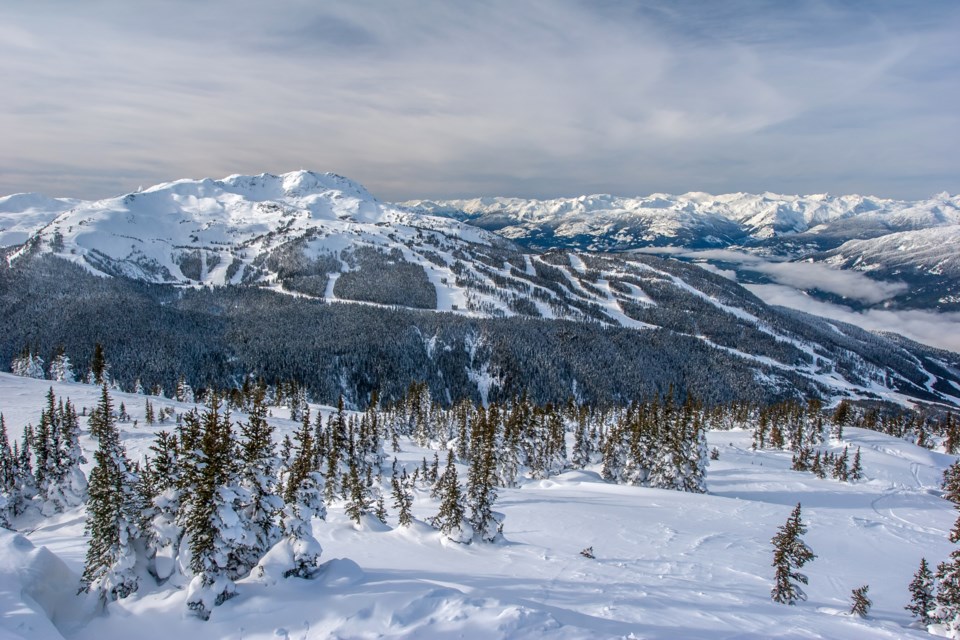The wet and relatively warm conditions of the atmospheric river that rolled through the Sea to Sky corridor last week resulted in a widespread avalanche cycle, which released many large scale avalanches in the Coast Mountains during the height of the storm, according to Avalanche Canada forecaster Colin Garrity.
And despite current conditions not showing much risk of more avalanche activity, Whistler, and the Sea to Sky corridor, aren’t out of the woods just yet.
The heavy rain that hit a large portion of Whistler Blackcomb earlier in the week, created a hard-packed, icy surface called a “capping crust.”
And according to Garritty, as long as that crust is strong enough to support a person’s weight without them breaking through, there is no real chance of triggering an avalanche.
“That crust isn’t the kind of snow that can produce an avalanche itself, so basically if you cap the snow pack then you’ve capped all the problems under the snow by doing that,” he said. “Where that crust doesn’t exist or it’s really too thin to support your weight, there are still some layers in the snowpack that are concerning, and these are the same layers that would have been producing large avalanches during the storm.”
Despite the recent avalanche cycle clearing out many of the problem spots, areas where the crust is weaker, as well as wind slabs created by the redistribution of snow, still represent risks for more potential avalanche problem spots.
However, the biggest question mark as to what the avalanche situation looks like going forward comes down to what the next bit of precipitation looks like.
The best-case scenario, according to Garritty, would be for the next snowfall to start warm and wet before cooling off, as this would allow the new snow to form a strong bond with the current snow crust.
But, if the snow comes in cold and dry and builds up on top of the crust without a chance to properly bond, it could create perfect conditions for that new snow to slide and more avalanches to occur.
“So when we get new snow that piles up above that crust, that hard-bed surface does contribute to the likelihood of avalanches. It will be a great sliding surface for avalanches in the future, but not only that, this dry period that we are heading into right now, we are very likely to see weak, new-surface grains forming on the surface of the snowpack between now and the next snowfall,” said Garritty. “So in the meantime, during this little drought period, the snow surface is going to be developing this weak stuff that is going to get snowed on, there is going to be a really nice bed surface under it, and it’s very likely going to create quite active avalanche conditions.”
As predicted by Environment Canada warning preparedness meteorologist Armel Castellan, the most recent atmospheric river to roll through Whistler last week unfortunately didn’t bring with it the wet snow needed to bond to the already-present crust.
Instead weak crystals “like a feathery surface hoar were observed growing between dustings of snow” before being buried by a new layer of snow creating what could potentially lead to more avalanche issues in the future, according to the latest Avalanche Canada update.
“This kind of setup can have long lasting implications reaching all the way into spring, when they will be deeply buried and potentially capable of producing very large, destructive avalanches,” read the emailed statement.
“Needless to say, this crust is likely going to be a player for the next few storms, at least. In the near future, the supporting details in the forecasts will become invaluable as you manage the potentially complex upper snowpack. As time passes and more observations come in, we’ll learn more about the nature of the problem and how best to manage it.”
With the strong chance for avalanche-friendly conditions this year, Whistler Search and Rescue (WSAR) recommends anyone planning a trip into the backcountry or outside of the controlled areas of the mountains make sure they have the proper equipment and education necessary for survival in an avalanche scenario.
“We certainly recommend that anybody that is considering leaving the controlled recreation area take an avalanche safety training level one course as a beginner,” said WSAR president Brad Sills.
“Also, there is mandatory equipment if you are going to leave the ski area and that consists of a transceiver, a shovel and a probe. But it’s not sufficient enough to just acquire these, you need to learn how to use them and to train with them regularly.”
WSAR responded to approximately 12 avalanche-related calls last winter, three of which resulted in fatalities.
For more resources and information on what to do in the case of an avalanche, Sills recommends visiting adventuresmart.ca.




